This post may contain affiliate links. I only recommend products or services that I personally use or trust, promise!

Fish jorim is one of the MOST underrated Korean dishes in my opinion! This is something my mom made a lot when I was growing up, and it’s still one of my all-time favorite Korean foods. If you’re new to Korean cooking and want to try something different, I highly recommend trying this!
It’s not a dish you will see on many Korean menus. Now that I’m thinking about it, I can’t say that I’ve ever seen it on a menu at any Korean restaurant I’ve been to in the states (although I’m sure some restaurants do serve it). So that’s all the more reason to make it!
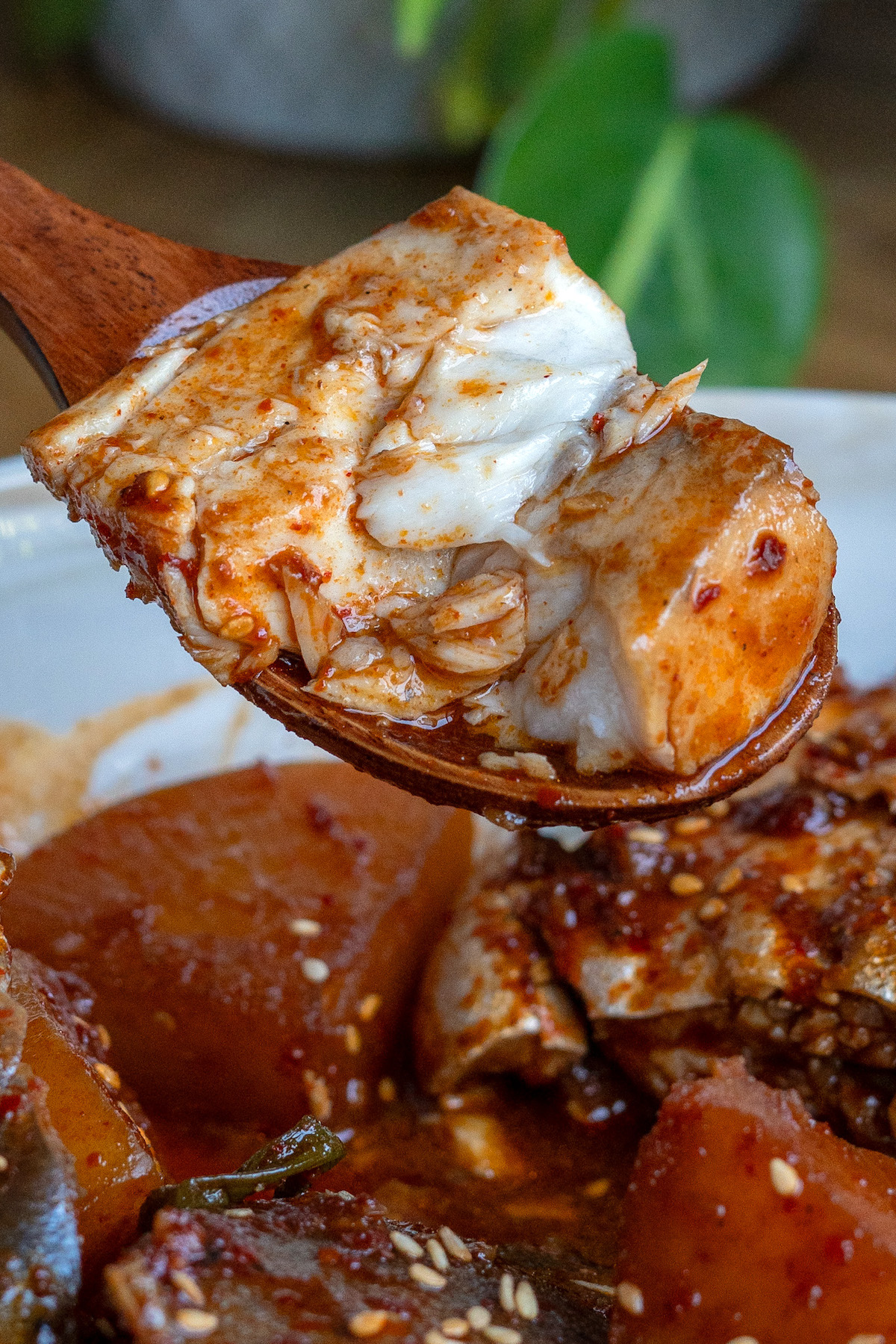
What is fish jorim?
The word “jorim’ usually refers to anything that is braised in a sauce. Although “fish” jorim isn’t the proper name for this dish, I’ve labeled it that way because this recipe can be used to make all the different kinds of fish jorim there are (which I will talk more about later).
The fish is usually cut into steaks, but you can use filets too. The fish is then laid on top of Korean radish (mu), and covered in a sweet & spicy braising sauce and some veggies. The Korean radish soaks up the braising liquid flavor and is often considered the best part to many Koreans! It’s definitely my favorite part, but my husband does not like Korean radish.
As I mentioned earlier, this is not a dish you will see on a lot of Korean restaurant menus- but it is something that is made quite often at home. My mom made this dish at least once a week growing up as it was her favorite, and it has become one of my favorites as well!
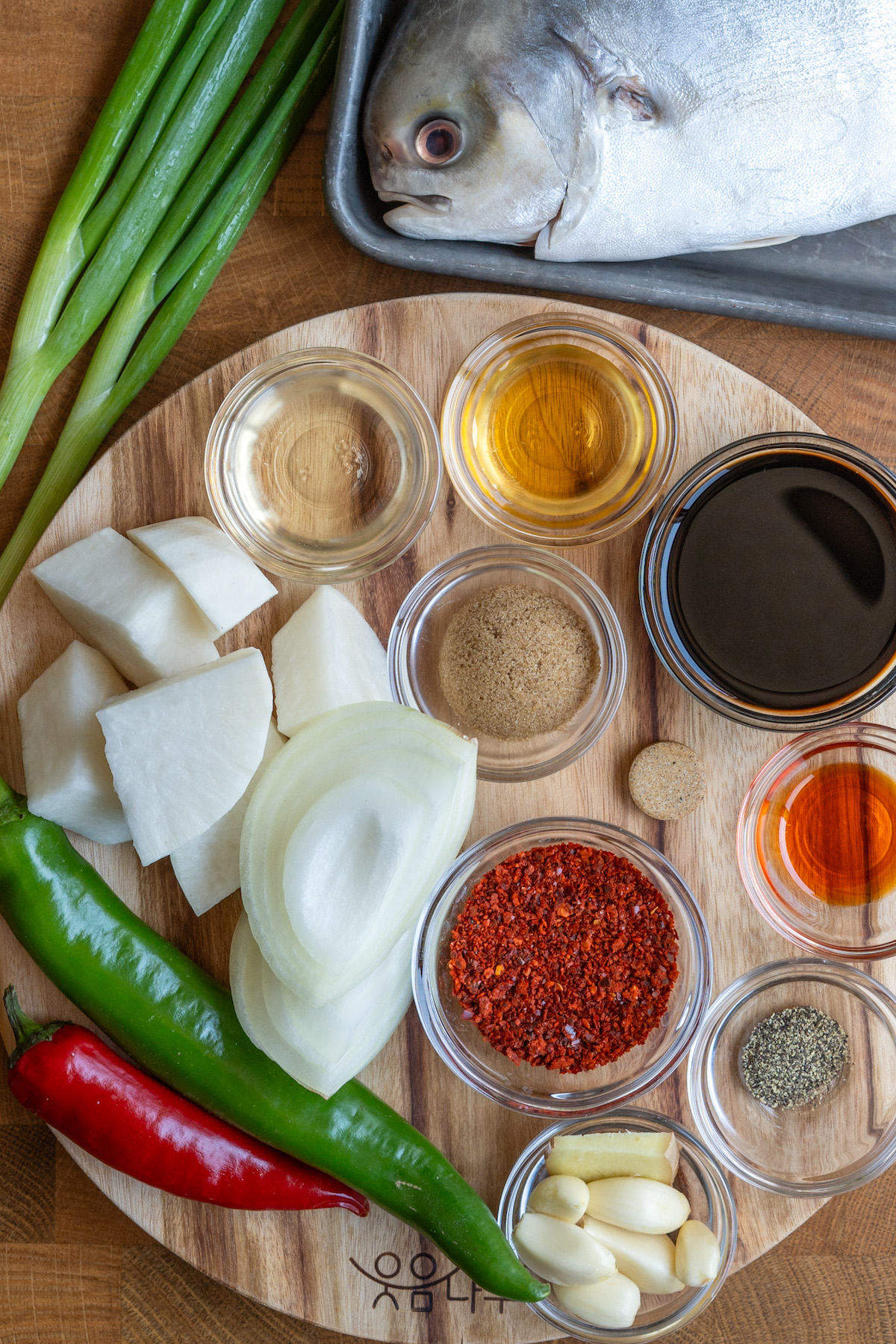
Ingredients
- Fish- I’m using golden pompano for this recipe because it’s the only fish my husband deems as “not fishy.” You can use any fish you like, and for the most part it will be the same preparation. I will touch on this more later.
- Braising sauce– anchovy stock, soy sauce, gochugaru (Korean red pepper flakes), garlic, ginger, brown sugar, sesame oil, black pepper, and Korean cooking wine (matsool).
- Korean radish (mu)- I find that most Koreans either love or hate this ingredient in stews and braises. Either way, this is an important ingredient and shouldn’t be left out. The juices from the radish give the braising liquid a distinct flavor that will be missing if you omit it. The radish also perfectly soaks up the flavor of the braising liquid, and many consider this to be the best part!
- Aromatics- onion, green onion, and chili peppers.
- Optional: potato- potatoes are not traditionally part of this dish, but as I mentioned earlier my husband does not like Korean radish. I add potatoes to it for him since they also soak up the sauce wonderfully, and who doesn’t like potatoes?
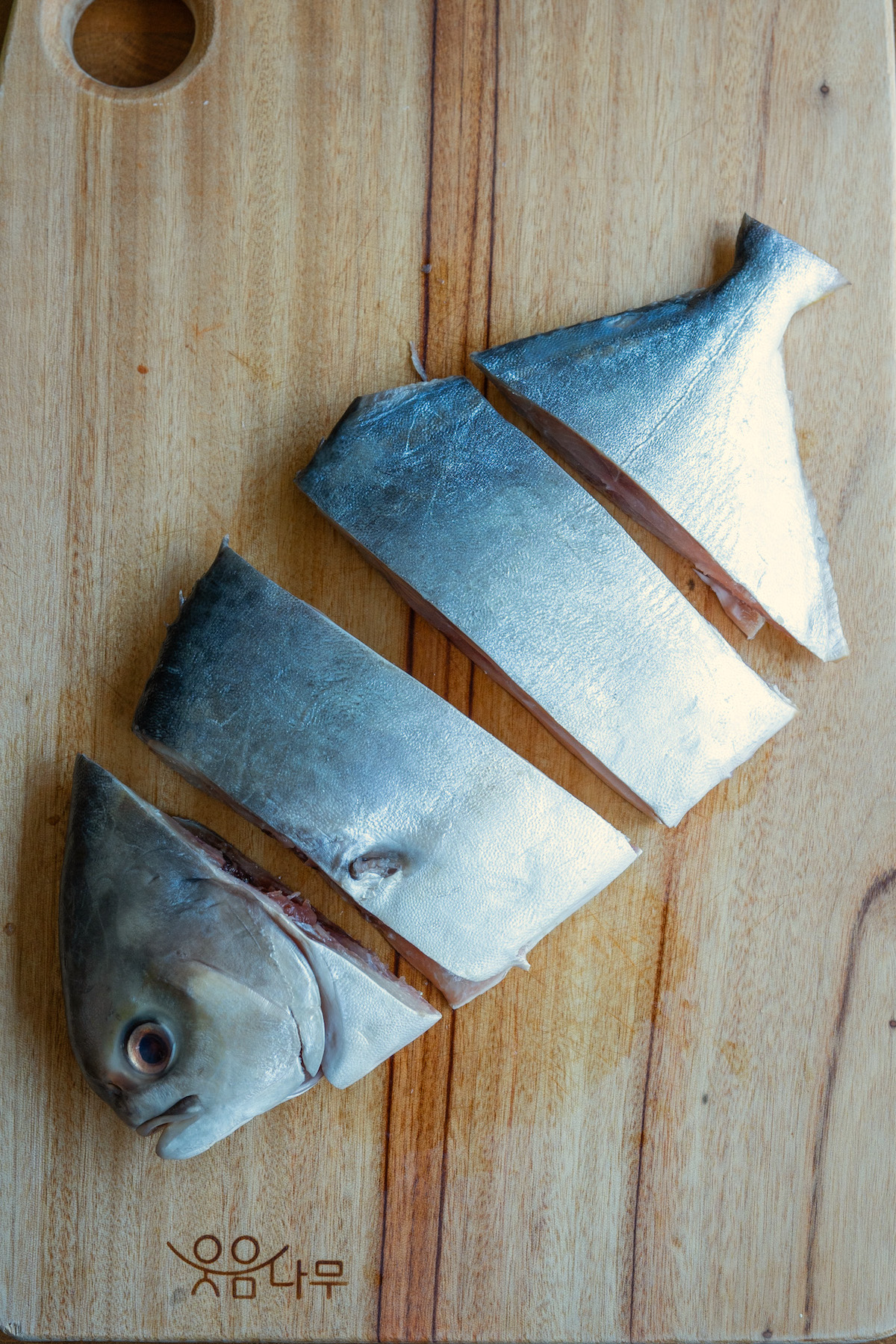
Other types of fish you can use for this recipe
You can use this recipe to make any kind of fish jorim, but some types of fish may require special preparation. Here is a list of the most popular fish to use:
- Mackerel (godeungeo jorim)- my favorite fish jorim! Mackerel is very affordable, easy to handle, and so delicious. It’s a very oily fish, so it’s a great source of omega 3’s as well. Some people may find it a bit too oily & fishy, so if you’re sensitive to these flavors I would suggest a different fish.
- Cod (daegu jorim)– cod is a great choice if you want a meatier fish, which will leave you feeling much fuller. However, out of all the choices I’m talking about in this section, this is my least favorite fish to use for jorim.
- Beltfish (galchi jorim)- this is my top choice for fish jorim! Beltfish is a delicious, delicate fish that is very popular for jorim. The only caveat to using beltfish is that it requires a bit more preparation, because of its very fishy skin. You can find out more about the preparation from my galchi jorim recipe I posted a few years ago. It is an older recipe, but all the info is there for you!
- Golden pompano (byeongeo jorim)- I’m not sure if this is a popular choice in Korea, but my mom recently made it and I noticed how NOT fishy pompano is. The meat is tender, moist, and meaty but flakey at the same time. This is what inspired me to post this recipe actually- since my husband doesn’t like this dish because of “fishy” flavors, I thought maybe he could tolerate or even like pompano jorim. And I was right! He loves this dish when made with golden pompano & potatoes!
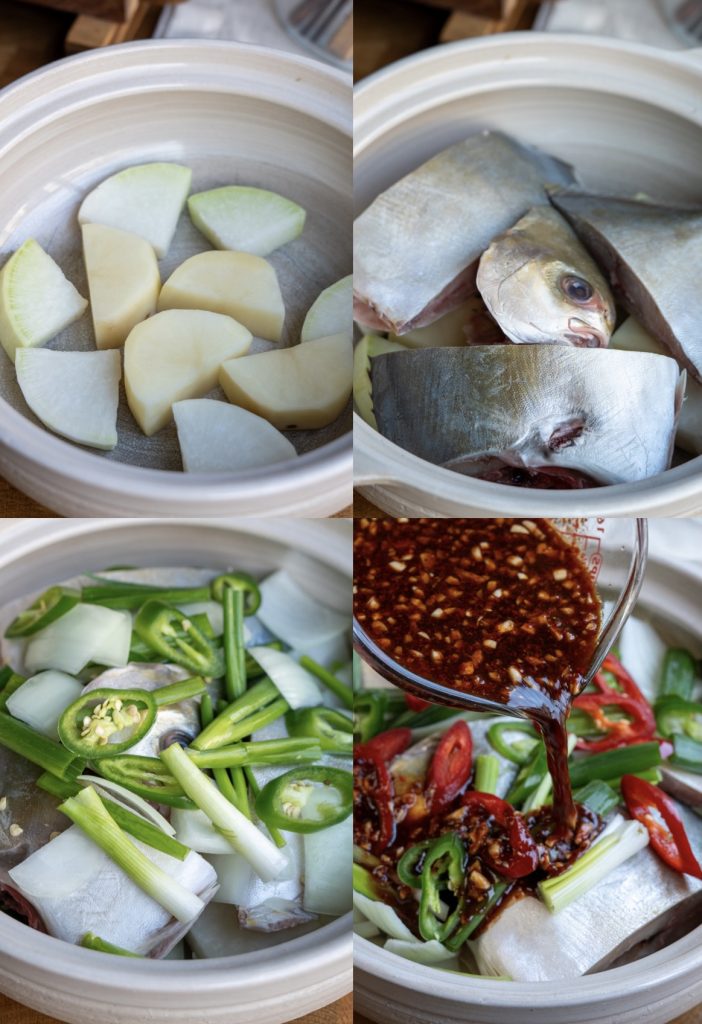
Why you’ll love this recipe
- It is extremely easy to make! This is pretty much a one-pot dinner, and nothing needs to be added or taken away while it is cooking. Just set it and forget it, and dinner will be ready in no more than 30 minutes!
- It tastes even better the next day, making it excellent as leftovers! I feel like this is usually the case with anything that is braised, and it is especially true here. I love having leftovers for breakfast- it is really something that I look forward to.
- Fish is good for you. Load up on omega-3’s with this delicious & healthy meal. I usually have a healthy banchan (side dish) like seasoned spinach or bean sprouts to pair with it as well.
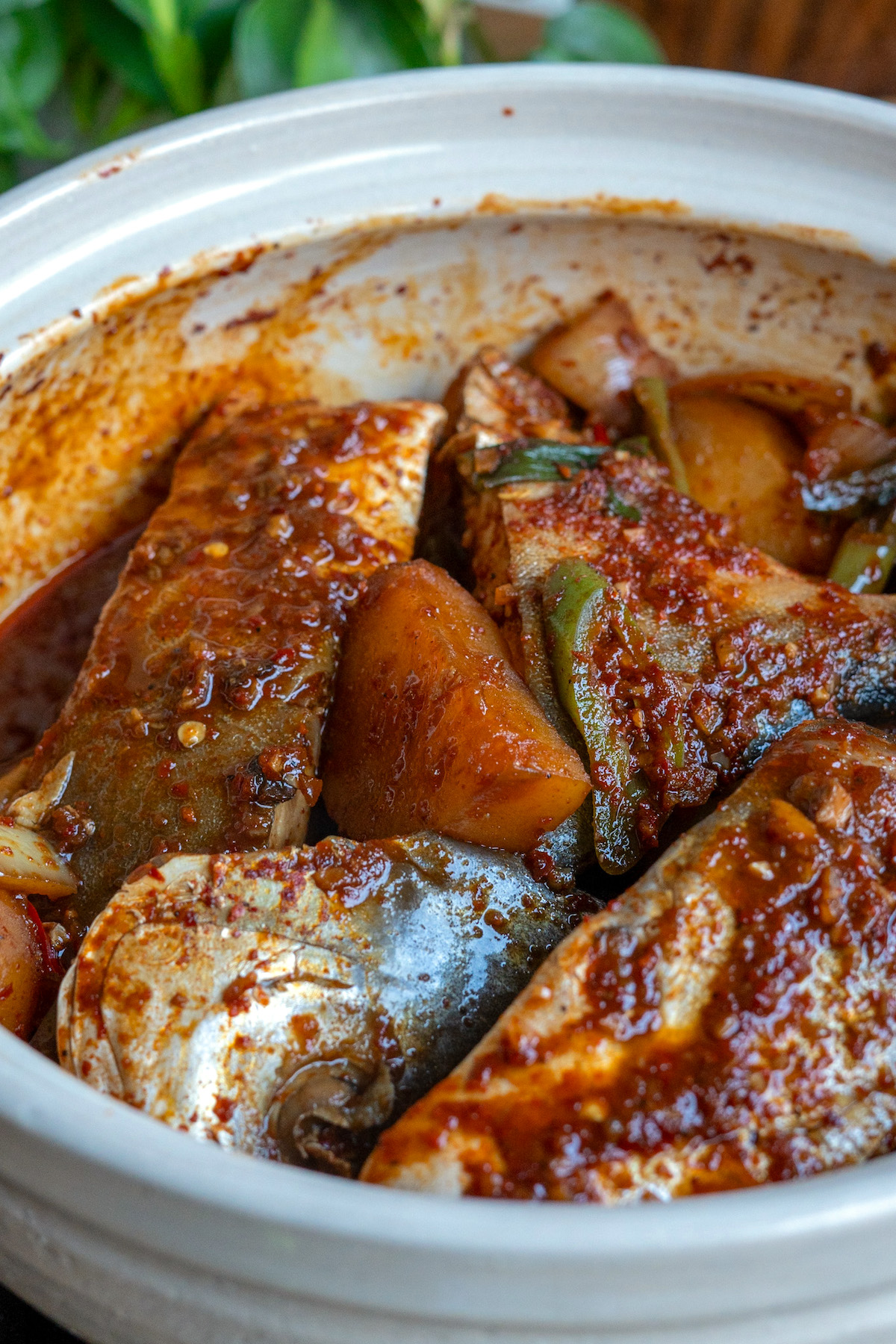
How to enjoy fish jorim
Depending on the fish you use, you may need to spend some time pulling out the bones. For this recipe made with Golden Pompano, you don’t need to worry too much about bones! The meat is very easy to get from the fish, and the skin is also edible and not too fishy.
I highly recommend spooning the braising sauce over your rice, and making each bite with rice, a piece of fish, and a piece of the radish. You may even find yourself reaching for just the radish at times- it is really, really good!
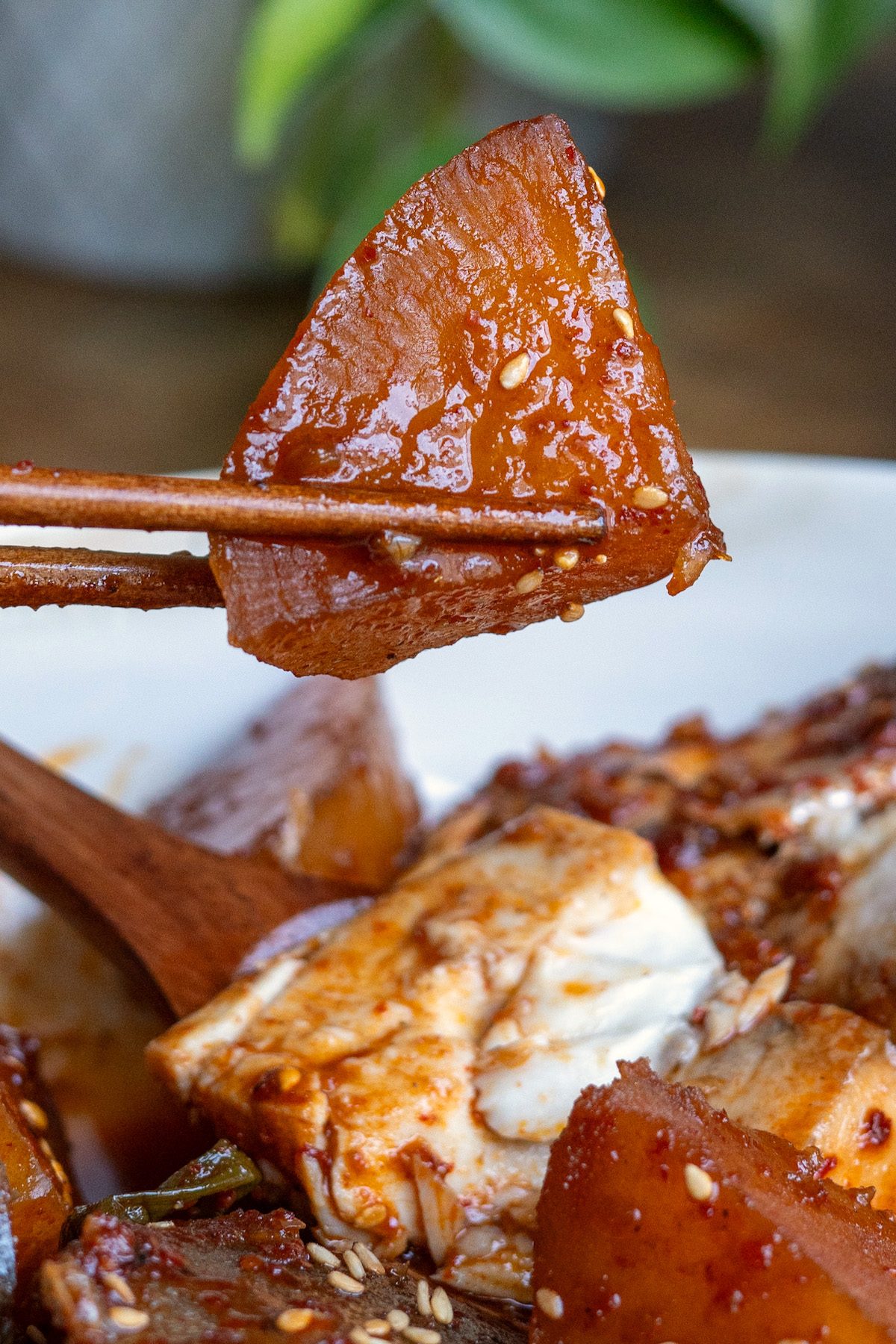
More spicy braised Korean recipes
If you like this recipe, try some of my other similar recipes on the blog!
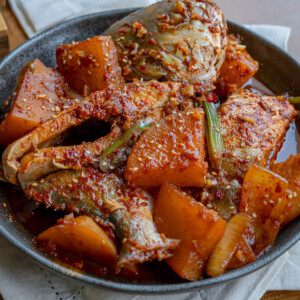
Fish Jorim (Korean Spicy Braised Fish)
Ingredients
- 1 lb golden pompano cleaned & gutted, or mackerel, cod, beltfish
- 1/2 lb Korean radish (mu), optional: 1/4 lb radish + 1/4 lb potato
- 2 green onions
- 1/4 onion
- 1 Korean green pepper
- 1 red pepper
Braising sauce
- 3/4 cup anchovy stock, I used 3/4 cups hot water +1 anchovy tablet
- 1/4 cup soy sauce
- 3 tbsp gochugaru (Korean red pepper flakes)
- 2 tbsp matsool (Korean cooking wine)
- 1 tbsp brown sugar
- 1 tbsp oligodang (cooking syrup)
- 1/4 tsp black pepper
- 1/2 tsp spicy sesame oil
- 5 garlic cloves
- 1/2 tsp fresh ginger
Instructions
- Prepare all the vegetables: mince the garlic & ginger, slice the peppers, green onion, and onion. Cut the Korean radish into 3/4 inch discs, then quarter them into triangles. *If using potatoes, cut them into a similar size as the Korean radish, but into a different shape (I did half moon) if you want to be able to tell them apart. My husband hates accidentally biting into radish when he thought it was a potato!
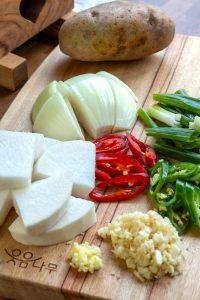
- Combine the braising sauce ingredients, mix well and set aside. *For the anchovy stock, you can make it from scratch using dried anchovy + dried kelp, or you can dissolve 1 anchovy tablet with 3/4 cups hot water.
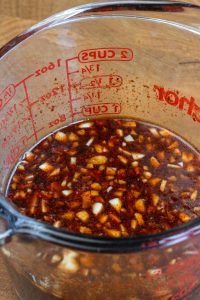
- Carefully cut the golden pompano into steaks. Use a cleaver if you have one, because the backbone is a bit thick. Don't throw away the head or tail! These are some of my favorite parts of the fish- they have the most flavor.
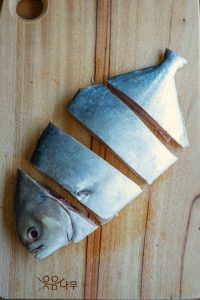
- In a wide and shallow pot, place the Korean radish (and potatoes, if using) in a even layer at the bottom.
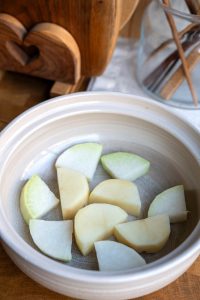
- Next layer the fish on top.
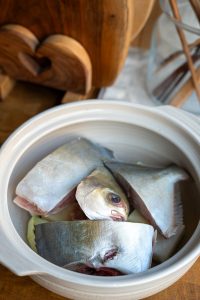
- Add the rest of the ingredients on top of the fish: green & red peppers, onion, and green onions.
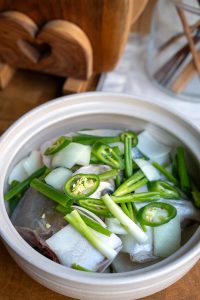
- Pour the braising sauce over everything. Cover and cook over medium-low heat for 20 minutes, checking on it every 5 minutes or so to make sure the bottom does not burn.
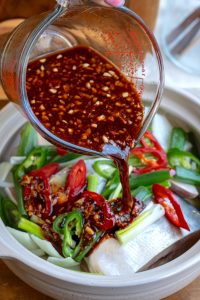
- While checking on it periodically, ladle the braising liquid over the fish several times to keep it moist and impart flavor.
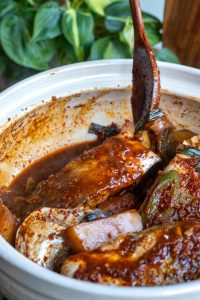
- When the Korean radish (and potatoes, if using) is chopstick tender, it is ready to serve (about 15 minutes).
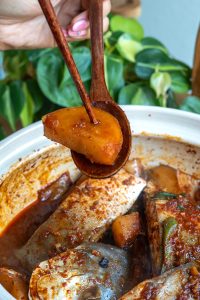
- Sprinkle some sesame seeds on top and enjoy with a fresh bowl of steamed rice 🙂
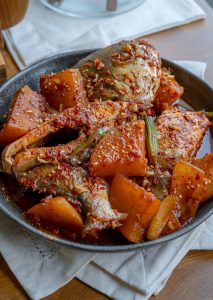
Nutrition information is automatically calculated, so should only be used as an approximation.
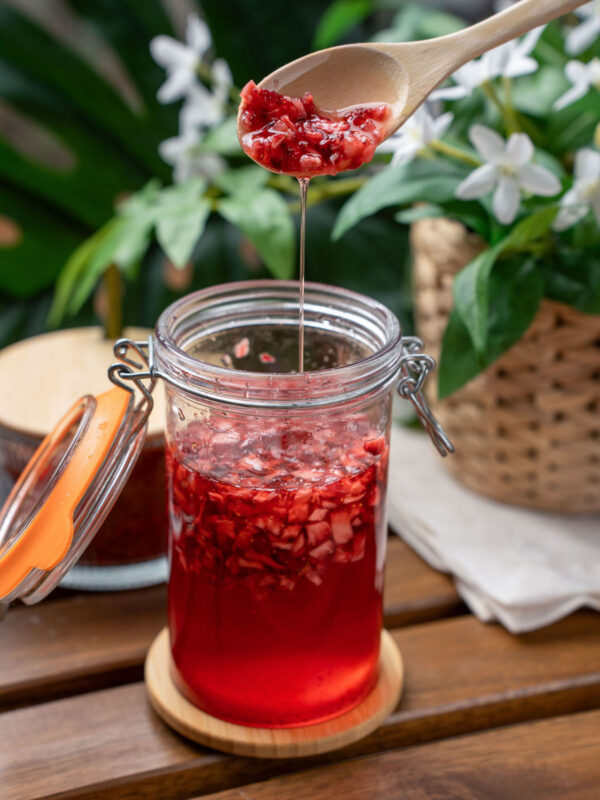
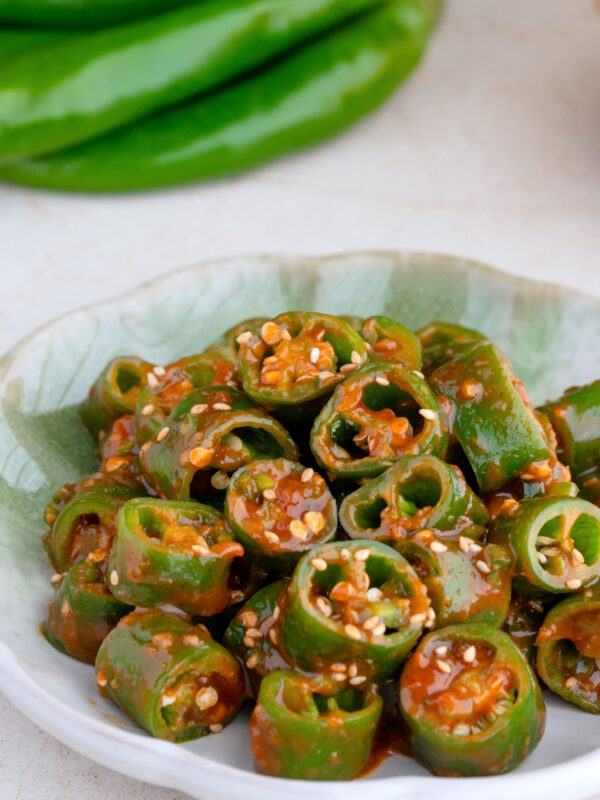
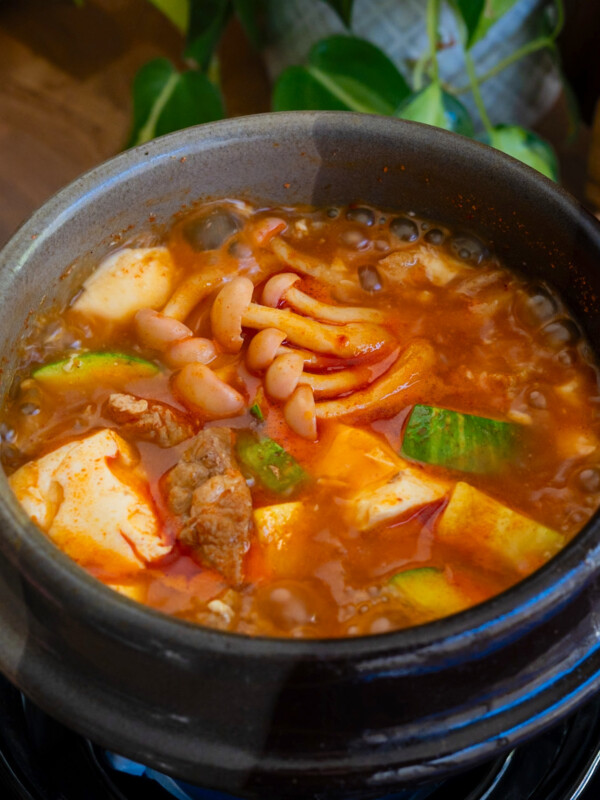
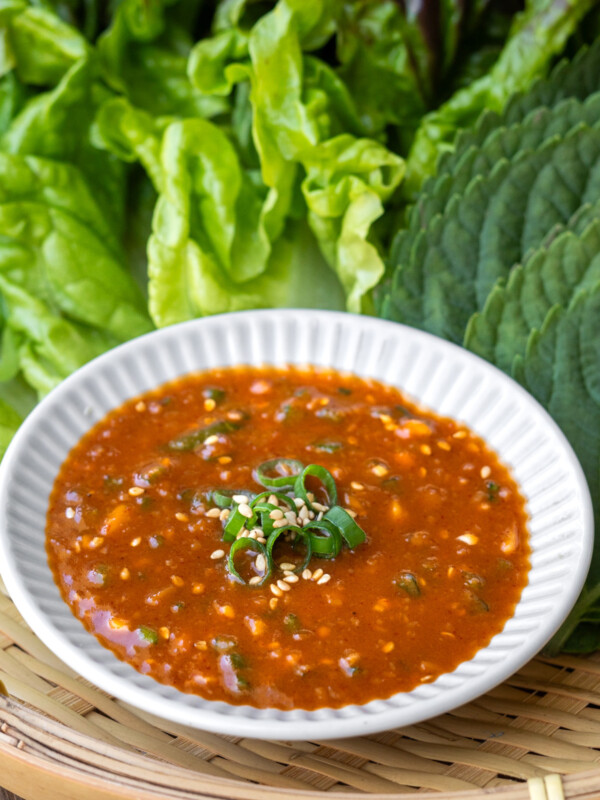
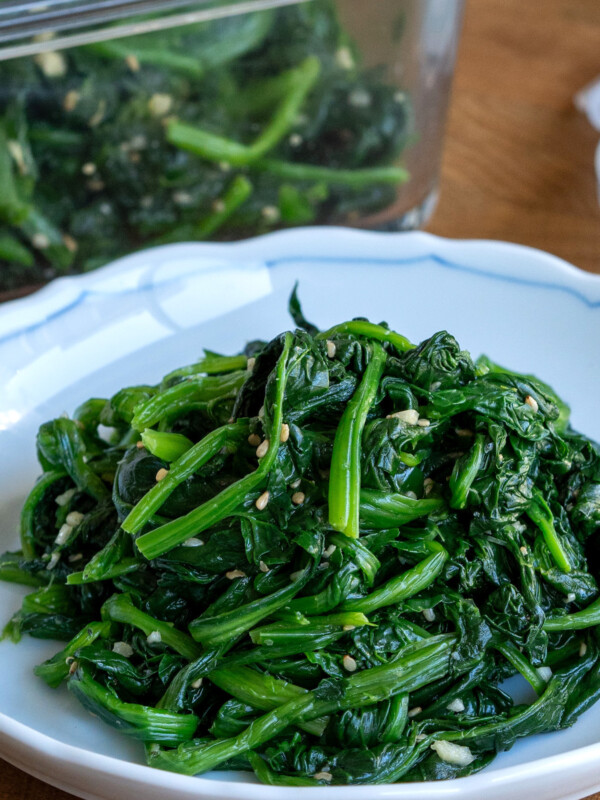
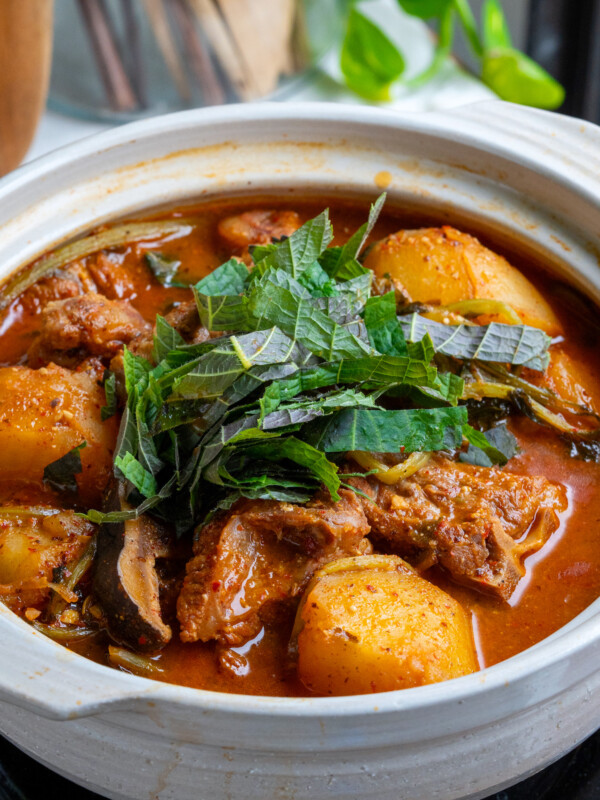
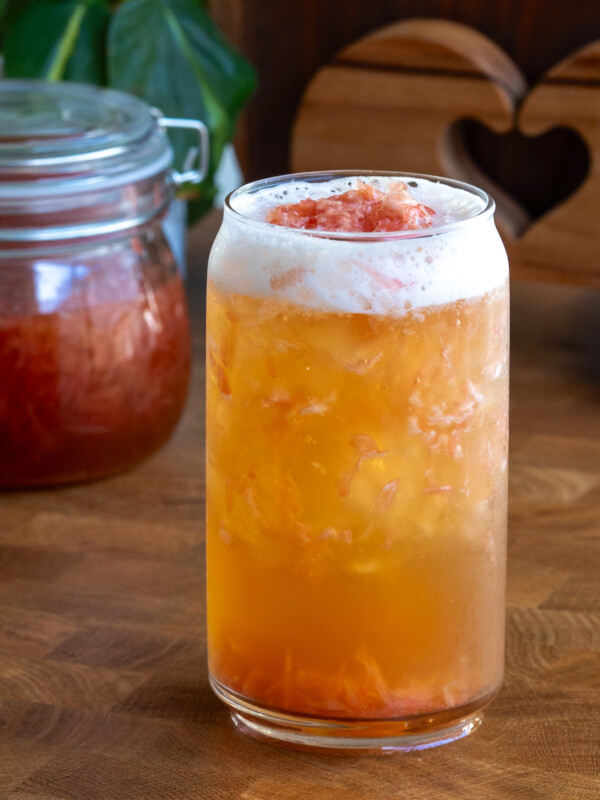








What are good substitutes for matsool and oligodang?
For matsool you can use mirin, for oligodang you can use granulated sugar.